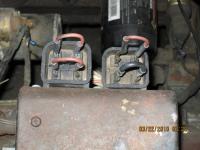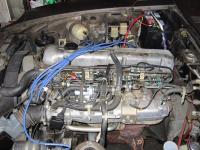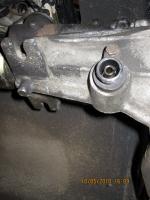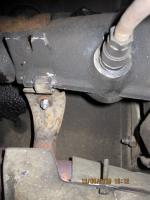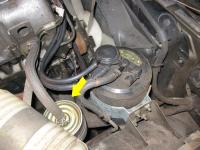Everything posted by Zed Head
-
Stock Wiring Near Battery?
It looks like someone removed your fusible links and mounting fixture entirely. Here are a picture of fusible links from a 76 and 78. The 76 is the full engine shot. The 78 is the closeup from the top. Your 77 should look very similar. The red/white wires in your picture probably used to run up to the bottom of the fusible link fixture. The links are under the two white plastic covers in the full engine bay shot. You should probably re-protect those wires while you're finding and fixing your short.
-
1976 280 Z No power
Did you have the oil changed at one of the name brand quick oil change shops or the local mechanic? Maybe someone took a joyride. 32 psi is below the 36 psi recommended in the FSM. But your black plugs suggest rich running so that doesn't really fit your picture since low pressure should run lean. You didn't put a number on cylinder #6 - "The 6th one has on it." ???? You say the car will run until it warms up. Do you mean it will actually drive down the road like a normal car when cold, then lose power when it gets warmed up? Or it will run in the driveway, then backfire when you give it gas after it warms up?
-
Backfiring when heated up...Why?
The sound of "valves about to jump out of the motor" while climbing an incline might actually be "knocking" or detonation, which could be from incorrect timing. It's very bad for the engine.
-
Replaced master/slave cylinders - still no pressure
You don't want to "pump." Press down, hold down while releasing the bleed screw, tighten bleed screw, then release pedal. That's why an assistant helps. If you let the pedal up with the bleed screw open, air will suck back in to the lines, whether working at the master or the slave. Things will get worse because you pump fluid out and let air in.
- Where do i start?
-
Telling the Difference Between Early Four and Five Speeds
I've seen this topic come up several times but never found a good description of how to tell. I realized today that I've seen one distinct difference between an early 280Z four speed and a 280z five speed. So I took a couple of pictures for the record. One is a 1976 four speed, the other a 1978 five speed. The difference is in the straightness of the housing across the bottom of the speedometer drive gear mounting area. The five speed is essentially straight while the four speed diverges at the housing. The old timers probably know how to tell at a glance, but I have not been able to find a good writeup of how to tell them apart visually. Both are mounted. The 76 4 speed is first, not in use, but mounted in a car. The 78 5 speed is second, currently in use.
-
Modified differential mount
It looks good in concept. But I think you'll find that when you tighten the nut down the top plate will pull down until it's edge (front or back, can't remember which) contacts the "diff mount front member" (cross member) lip. Effectively giving you a solid mount (metal on metal). The "clunk" will be gone but you might get more vibration. If you don't crank it down, you'll need a self-locking nut or similar to keep it tight. Not trying to be joy-killer, just something to watch for when you tighten it up. I have stared at that edge for quite a while trying to figure out how to work around it. the designers made it so tight, it only sits about an 1/8" above the lip normally.
-
1976 Datsun 280z Chokes PLEASEEEEEEEEEEEEEEEE help
I hate to ask, but have you or Mike's measured the fuel pressure? Sounds like you're a little low, maybe a clogged inlet screen, clogged filter, or bad pump. If you have good pressure, then you'll know to look somewhere else, like timing or vacuum leaks. And it sounds like they might have swapped in a used AFM? You didn't say "new." Coughing at part throttle is what my bad AFM was doing. But it went pretty well at open throttle. Idle - good, part throttle - stumbling and bucking, open throttle - goes fast. I would check fuel pressure first, check timing and make sure it advances properly, and look for vacuum leaks. I've been talking quite a bit out here on classiczcar. Hope no one minds. I don't want to monopolize the conversation.
-
1976 Datsun 280z Chokes PLEASEEEEEEEEEEEEEEEE help
Choke?
-
Getting around 11 MPG, running rich, need help
I was getting about 18 also before I put an aftermarket regulator on. Now I get a consistent 20 (at least 6 fill-ups calculated since I put it on). I have a 76. jthill3 - Just for my own personal interest, what fuel pump and regulator are you using? I'm still wondering about these high rate, high pressure pumps that the auto stores sell as replacement pumps for the Z cars. Edit - I agree on FP measurements. A little disappointed that Z Tyler Z didn't measure before replacing parts but good luck to him.
-
Getting around 11 MPG, running rich, need help
There is one other possibility for high pressure. It might be that some of the aftermarket fuel pumps push too much fuel for the stock regulator to handle. I realized that I have had three stock regulators give high pressure using aftermarket pumps. Two were with a new Carter fuel pump, giving 43 and 40 psi on two different regulators, on a 78 engine. The other was with an Airtex E8312 on a 76, giving variable high pressure depending on temperature. Just a possibility. I tried to experiment with a 6 volt dry cell to compare but it couldn't put out the juice. I don't have any way to confirm and can't find any data on flow rates. More and more aftermarket pumps are ending up on the Zs because they are quite a bit cheaper and that's what the auto parts stores sell. I wonder if it's one more reason that so many people have the "running rich" problem.
-
Getting around 11 MPG, running rich, need help
The FPR can fail open (low pressure) or it can fail (clog) closed (high pressure). The stock fuel pumps have a bypass that kicks in at 43 psi. So you can have a clog in a return line or a failed (clogged) FPR and the car will still run, just really rich. If you have an aftermarket fuel pump, you could get some very high fuel pressures, since many don't have a pressure bypass.
-
Getting around 11 MPG, running rich, need help
Fuel pressure is key. It affects everything.
-
'77 Fuel Problems
The fact that your car runs fine when cold suggests that the fuel system can "keep up" with demand. You should have mentioned this in the beginning. If you can confirm whether or not the fuel pressure drops before or after the engine dies, you'll be way ahead in figuring out your problem. In post #3 I see that you did remove the vacuum line from the regulator and saw no change, sorry I missed that. You should have seen the pressure increase to 36 psi when you removed that line. 30 psi is fine at idle, but the ECU and injectors expect more when the throttle is opened. You have many odd bits of information scattered around. The answer is in there somewhere.
-
'77 Fuel Problems
I got side-tracked with the focus on fuel pump, fuel filter, etc. 30 psi is not too bad at idle, it's actually a little high (for idle). But with your car idling, if you take off the small vacuum hose from the center of the regulator that is connected to your manifold, your fuel pressure should jump up to 36 psi. Don't pinch that one, take it off. You'll hear it hissing and the idle rpm should jump a little bit. Plug the end of the hose with your finger to stop the vacuum leak to the manifold. When you put it back on, the fuel pressure should drop. Anyway, sorry I couldn't be more help. Another video, showing the car actually idling, with a shot of the pressure gauge as you press the throttle linkage, might give some clues. If your FPR and fuel supply is working correctly, then the next fuel supply component in line is the AFM. When the throttle is closed , the AFM is not adding much, it has a bypass to let air through for idling. When you open the throttle, the AFM flap opens and signals the ECU that more fuel is needed. The Engine Fuel section in the FSM will tell you a lot.
-
'77 Fuel Problems
The symptoms seem to point to your regulator. If the valve in the regulator is stuck at a certain flow rate, then the pressure reading would be constant and unaffected by the removal of the vacuum line. You can test your pump by pinching the return hose off the regulator. The pressure reading should go up. If you have an OEM pump it should go up to about 43 psi. But be careful if you have one of the generic pumps the auto stores sell, they usually can go up to 90 psi. If pinching the line causes the pressure to increase it suggests that your FPR is not doing its job (assuming everything is plumbed correctly). The other possibility is that your new filter or a clogged line somewhere is causing so much back pressure that the pump is maxed out and only 30 psi worth of flow is getting through. I would pinch the return line (slowly and carefully while watching the gauge) first and see what happens. If it increases, take the return line off and run it in to a container to make sure you're getting good fuel flow. If you are, then your FPR is probably bad. If you just get a trickle, you might have a clogged line.
-
Fuel Pump Relay Location
On a 76 it is actually right above the hood release handle, left of the steering column. Held in place with a couple of screws. About 1x1x2.5". Not sure where they put it in 77 though. One more place to look though. Per Steve Blake's comment - I have a spare 76 replay that came with my car. The previous owner bought it and found that that was not the problem. I don't think they go bad often. They don't suffer much abuse inside the car. The first thing that I would do is to disconnect the small wire on the starter, turn the key to Start and listen for the pump. It's just a small electric motor back by the gas tank. If you don't hear it then you can assume it's either dead or not getting power. If you do hear it, then you can focus on fuel lines, filters, tank, etc. You can't hear it with the engine cranking. Then before you take the pump out or change the relay (if you don't hear the pump), put a voltmeter on the pump contacts and have someone turn the key. This will tell you if the relay is working. etc, etc. It will save you some money.
-
New guy needs help
Here is a picture of the filter. It is big. But as EScanlon suggests, you should probably check a few things out before you start replacing parts. Jumping from "won't fire" to "change fuel filter" is not the best way to go. You can spend a lot of money and end up worse off than when you started.
-
What next?!
Full disclosure - I have a different name over on Hybridz. I was never a forum person until I got this car. I originally signed up just to see the pictures. Here is a related post by me on the same topic over at Hybridz - http://forums.hybridz.org/index.php/topic/94554-aeromotive-fpr-and-liquid-filled-pressure-gauges-underhood-heat-durability/page__p__890204__fromsearch__1#entry890204 Tony D had some good advice on gauges.
-
What next?!
I had spent months driving my stock 1976 car around trying to figure out why it seemed to run rich. Gassy exhaust, sooty plugs, 16 - 18 mpg all the time. The fuel pressure checked right at 36 psi on a cold engine. Finally, over about a week, the gassy smell got terrible (one guy behind me actually flipped me the bird as he passed, it was that bad) and the mileage dropped to 15 mpg. I checked the fuel pressure hot and found that my FPR had finally gone completely bad, pressure was up around 42 psi, maybe higher while I was driving. I installed an Aeromotive adjustable regulator (high quality Craigslist bargain) for the same reason you are thinking and the car runs much better, running like a normal car now. Clean exhaust smell, the idle doesn't drop to 500 momentarily when I stop, mileage improved to 20 mpg consistent. What I determined was that my original FPR allowed too much pressure when it got hot, but looked fine when it was cold. Expanding parts, seals going bad, whatever. So my checks on a cold engine didn't tell what was happening while I was driving. In summary, if everything else checks out, or maybe before you check everything else out, make sure that your FPR is working correctly, at running temperature. I get 36 now without the vacuum tube hooked up and about 25 at idle with it connected and the engine is running great. I did drive around with my temporary in-line gauge zip-tied down to verify pressure. A few odd facts - I can pull the tiny hose that pulls vacuum on the A/C canister and notice an increase in idle speed, it's that sensitive to leaks. If I pull the oil cap off it dies. The Aeromotive regulators will not hold pressure after the pump turns off. It is documented in the instructions that come with it. The valve inside is just a steel ball on an aluminum seat, no polymer seal. (As a result, my engine, with the stock looped fuel rail, takes a few seconds to fill and repressurize the the rail before starting. With the old (bad) FPR it would hold pressure and start right up.) One more thing - Months ago, I had the typical warm start problem, where the car is hard to start then runs like dirt for about 10 seconds, back when I had a set of injectors going bad. I put six new BWD injectors in and that problem is completely gone. In retrospect, it seems like the old injectors might have been flooding the manifold with gas, as they leaked out. Just a guess. Finally, for what it's worth, the liquid-filled pressure gauges can be heat sensitive and will read incorrectly. It is documented around the net. So be careful where you mount it if you get one. Sorry for the novel - just wanted to get it all out there...
-
water temp sensor/thermotime switch ID
The thermotime switch wires run to the cold start valve. You should be able to see the wires without tearing too much apart.
-
'69 240z, #299
Thanks for clarifying Mike. I missed your link to EvilC's comment. So what the Craigslist poster shows is not what he is selling.
-
'69 240z, #299
Things might have changed since those pictures were taken, looking at the old 2008 thread. I didn't realize that they were so old, and that this conversation has taken place before. I read through it but didn't see anything about four trees falling on it. That would change the situation.
-
'69 240z, #299
How can you tell so much from the pictures? I don't see any major damage. The driver's side floor pan is not rusted through, The only visible dents are the one on the front of the hood. I don't see any major rust-through. Engine and transmission still in it and hooked up. Suspension components ans wheels appear to be intact. Looks like it is missing some interior and exterior parts, but has all of the glass. Too bad it's so far away, the leaves and moss might be hiding a good project. It seems like #299 would be worth the effort. I'm new to the Z game though so maybe not.
-
77 Hi Beam trouble
I have mentioned this before but I had the same issue on a 78 parts car and just sprayed the dimmer switch at the base of the turn signal stalk full of Deoxit DN5, without removing it. It feels like cheating but it worked and it is still working. Also had the same problem with my current 76 car. I took the stalk and switch off, looked at what it would take to disassemble it, plus not knowing exactly what was inside, and decided to hose it with Deoxit first to see if that's where the problem was. It worked and I never did take it apart. It still works great. Both cars had sat for while, the 76 an unknown amount, and the 78 ten years, without being used.




